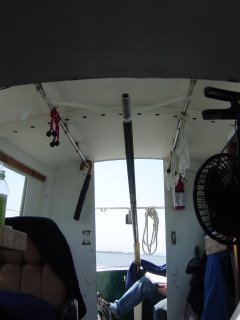Suisuin Bay to Owl Harbor



 The run from Suisuin Bay to the marina at Owl Harbor began mercifully late at around 1100.
The run from Suisuin Bay to the marina at Owl Harbor began mercifully late at around 1100.The tide had slackened, and we were rested from the last nights adventures. (see the next story, below) We set off on a starboard reach South from our anchorage at the Northwest point of Sherman Island. When we turned east onto the San Joaquin, our relative wind became so weak that we decided to motor-sail up the river, at least for now. With the doddering 34 year old outboard pushing us onward as best it could, we made good four knots over the bottom. We had previously discovered that this motor prefers not to work too hard, so we were limited to about 1/4 throttle excepting short bursts of "war emergency power".
After we crossed under the big bridge East of Antioch, the breeze began to freshen and we cut the motor as we turned onto a port reach to the Northeast. Fortunately this time we wouldn't be running from the law like the last time we were here, as the rain upstream had subsided and the delta was reopened. The revelations divined from the book of wishes turned out true (no doubt due to the sacrifices) and we had a fair current the whole way, often making over 6 knots over ground upstream, though our waterspeed probably never got much higher than 5.
After a beautiful and relaxing trip upriver (often looking down on the surrounding farmland, an odd sensation) we finally turned the bend that marked the entrance to Westward's permanent berth. Entering the narrow channel to the marina, we took down sail with perfect timing and motored (a guilty pleasure after watching the engineless Knarrs) into our berth at about 1600, well satisfied in our accomplishments.
I'm not telling what happened the next day, though I will hint that Westward performed handsomely in her short career as a cable laying ship. By the way, the crab cakes upriver at The Riverboat are quite edible, and the homeward beat upwind in the dark was challenging if uneventful.


1 Comments:
Can't wait to hear for the "rest of the story" :-)
Post a Comment
<< Home